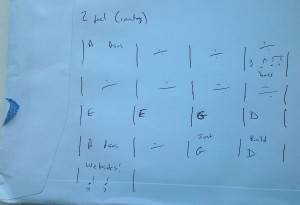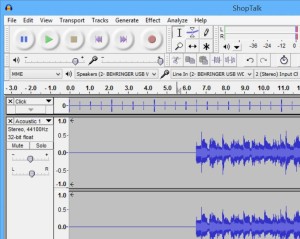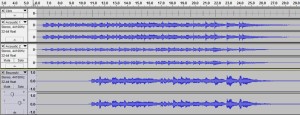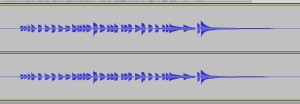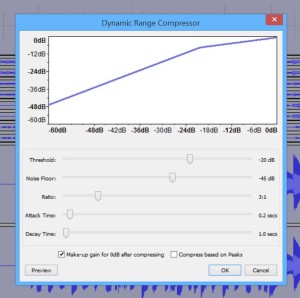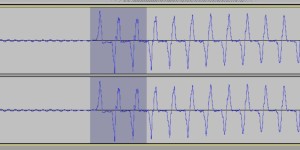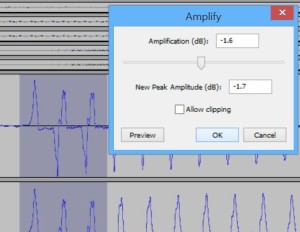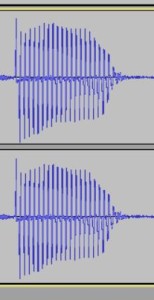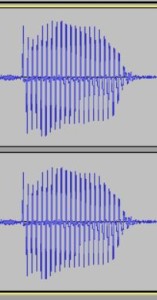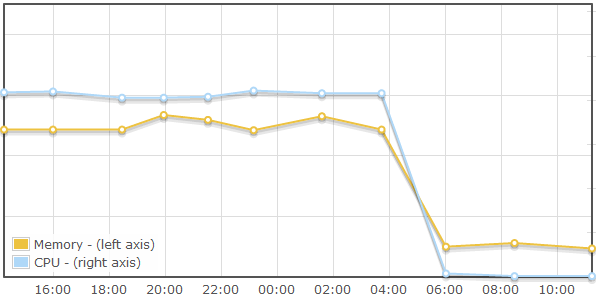I’m a member of the 12 Song Challenge community, a bunch of people all over the world who help support each other in the art and craft of writing songs for use in our local churches. It’s run by the people at Resound Worship, and I’ve found it to be a wonderful source of inspiration, friendship, and challenge.
Literally a challenge. Each month a songwriting challenge is set, based on a broad theme such as “Songs from the book of Acts” or “Happy Songs”. In November 2024 we were challenged to write songs with the assistance of “Artificial Intelligence”.
Hmm.
I have two problems with this.
I Don’t Believe A.I. Means What You Think It Means
While there’s a lively ongoing debate about what Artificial Intelligence (A.I.) even is, the term is incredibly popular at the moment. However, half the words in it (i.e. “intelligence”) are – at best – misleading. A.I. proper covers a wide range of computer-based systems, but most of the time on The Internet people use it to refer to systems that generate stuff from prompts – images, text, audio, or even – as we shall see – music. My gut feeling is A.I. has become popular as a term because a more specific term – for example A.G.S.P.O. (“Artifical Generation of Statisically Probable Outcomes”) – isn’t as easy to say.
The Cloud Is On The Ground
Second, people interact with A.I. systems through websites, often whimsically designed. It’s fun! Easy! And all in The Cloud. Except the cloud isn’t some abstract idea. It is real data centres, running real computers, containing real graphics processors, which require real energy to run, and real water to cool. The explosion in the popularity of A.I. tools – so much so that GPU manufacturer Nvidea became the world’s most valuable company in June 2024.
This reality is a problem. First, there is the mining of materials to produce the chips needed. Secondly, the emissions produced during the manufacture of these chips. Third, the emissions produced by the data centres themselves while running A.I. workloads. And fourthly, the use of water to cool these cips which run very hot. All of that is a problem because at the time we need to drasically reduce manufacturing, consumption, and emissions to help limit the man-made rise in global temperatures, we’re running gleefully into an A.I. future. And for what? Will the price that future generations pay be considered worth it?
Gerry McGovern has been writing about this stuff for years.
So, what do we do?
There’s no putting the A.I. genie back in the bottle. As A.I. tools become more prevalent I hope that more efficient ways are found to generate the energy and perform the cooling required. But I’m not hopeful that will happen fast enough to make a difference to the rapidy rising global temperature.
As Gerry McGovern [almost] says: we don’t have an [energy] production problem, we have an [energy] consumption problem.
The A.I. Challenge
With all that said, I had a songwriting challenge to do. Rather than boycott the entire thing (which was an option I considered) I wanted to use A.I. but keep my use of it to a minimum. I’d heard before that these tools work best when incorporated as part of a human-driven workflow.
As I’ve always found lyrics more challenging than music, I thought I’d start there.
Using ChatGPT for lyrics
I had already decided I wanted to write a song about the wisdom of God being infinetely better than the wisdom of man. Partly because I wasn’t aware of any songs specifically about that, but mostly because I wanted to make a small protest. So my initial prompt for ChatGPT was:
Write a modern worship song about the wisdom of god compared with the wisdom of man. Include descriptions of wisdom as being a voice crying out. Include the idea of wisdom being patient and gentle.
The response from ChatGPT was predictably naff, but was a starting point:
Title: The Voice of Wisdom
Verse 1
In the stillness, I can hear,
A gentle whisper drawing near.
The wisdom of the world so loud,
But Yours, O Lord, it stands unbowed.Chorus
Wisdom, crying out in the night,
Patient and gentle, guiding with light.
While the shadows of man may sway,
Your truth, O God, will lead the way.Verse 2
In the clamor, I find my peace,
Your voice, my heart, it will release.
The fleeting thoughts of human pride,
Fade away when You abide.Chorus
Wisdom, crying out in the night,
Patient and gentle, guiding with light.
While the shadows of man may sway,
Your truth, O God, will lead the way.Bridge
So I’ll lean on Your understanding,
In the quiet, Your grace expanding.
Teach me patience, teach me grace,
To find my strength in Your embrace.Chorus
Wisdom, crying out in the night,
Patient and gentle, guiding with light.
While the shadows of man may sway,
Your truth, O God, will lead the way.Outro
In every choice, in every sigh,
I’ll follow Your voice, I’ll lift my eyes.
For the wisdom of man may come and go,
But Your steadfast love will always grow.
I felt it could do better, so said:
Amend the song to include references about God’s ways being higher than human ways, and his understanding far beyond ours. Use analogies from nature.
And I got this:
Title: The Voice of Wisdom
Verse 1
In the stillness, I can hear,
A gentle whisper drawing near.
The wisdom of the world so loud,
But Yours, O Lord, it stands unbowed.Chorus
Wisdom, crying out in the night,
Patient and gentle, guiding with light.
Your ways are higher, like mountains soar,
Your understanding opens every door.Verse 2
In the clamor, I find my peace,
Your voice, my heart, it will release.
As rivers flow beneath the sky,
Your wisdom, Lord, will never die.Chorus
Wisdom, crying out in the night,
Patient and gentle, guiding with light.
Your ways are higher, like mountains soar,
Your understanding opens every door.Bridge
So I’ll lean on Your understanding,
In the quiet, Your grace expanding.
Teach me patience, teach me grace,
To find my strength in Your embrace.Chorus
Wisdom, crying out in the night,
Patient and gentle, guiding with light.
Your ways are higher, like mountains soar,
Your understanding opens every door.Outro
In every choice, in every sigh,
I’ll follow Your voice, I’ll lift my eyes.
For the wisdom of man may come and go,
But Your steadfast love will always grow.
OK, better, but not quite there yet. I wanted to make it sound a little less formal and hymn-like, as many modern worship songs have a more fluid syllable structure. So I said:
Make the number of syllables for each line in the verse different.
But ChatGPT seemed to latch on to “number of syllables” and added those to the end of each line while making minimal changes:
Title: The Voice of Wisdom
Verse 1
In the stillness, I can hear, (8)
A gentle whisper drawing near. (8)
The world’s loud wisdom, oh so proud, (9)
Yet Yours, O Lord, stands unbowed. (7)Chorus
Wisdom, crying out in the night, (8)
Patient and gentle, guiding with light. (9)
Your ways are higher, like mountains soar, (9)
Your understanding opens every door. (9)Verse 2
In the clamor, I find my peace, (8)
Your voice, my heart, it will release. (8)
As rivers flow beneath the sky, (8)
Your wisdom, Lord, will never die. (7)Chorus
Wisdom, crying out in the night, (8)
Patient and gentle, guiding with light. (9)
Your ways are higher, like mountains soar, (9)
Your understanding opens every door. (9)Bridge
So I’ll lean on Your understanding, (9)
In the quiet, Your grace expanding. (9)
Teach me patience, teach me grace, (8)
To find my strength in Your embrace. (8)Chorus
Wisdom, crying out in the night, (8)
Patient and gentle, guiding with light. (9)
Your ways are higher, like mountains soar, (9)
Your understanding opens every door. (9)Outro
In every choice, in every sigh, (8)
I’ll follow Your voice, I’ll lift my eyes. (9)
For the wisdom of man may come and go, (10)
But Your steadfast love will always grow. (9)
I tried a couple more times, but ChatGPT wasn’t going to improve this, and my A.I. prompt skills are minimal, so I took the lyrics above and used them as a starting point. These are the lyrics I actually wrote, you can see the similarities with what ChatGPT generated.
Verse 1
When the inner voice is loud
And vain desires are shouting out
I think that I can do it all myself
After striving to the end
I find I’m at the start again
I know I need your wisdom and your helpChorus
Your wisdom is calling
Your wisdom will guide us
Your words like a friend who walks close beside us
Your ways are far higher
Your love beyond measure
We’ll trust in your goodness foreverVerse 2
In the stillness I can hear
A gentle whisper drawing near
It speaks of love too vast to comprehend
In Your mercy I find peace
Your grace will bring my soul release
You know me better than I know myselfBridge
So I’ll lean on Your understanding
Your ways are higher than I could imagine
Teach me patience, teach me grace
Help me always walk your ways
These lyrics aren’t going to win any awards (I told you I wasn’t good at them) but I have to admit I wouldn’t have got this far so quickly without a kick-start by ChatGPT. So maybe that’s something I can use in the future.
Using Suno for music
One of the most astounding pieces of technology I saw this year was Suno. This A.I. tool takes prompts – you can select musical styles or other prompts, and optionally give it lyrics – and it will generate music, with vocals. The recording quality is pretty terrible, but you do get a fully-produced track. Guitars, drums, bass, keyboards, synths, melodic bits, vocal, the lot. Pretty incredible.
So, I posted my lyrics in, along with the prompt:
Contemporary worship, medium tempo, big build, compressed piano, toms, male vocal
And after a few seconds wait I got this:
Actually, I got two songs – Suno always gives you two options. This was the one I liked better, but interestingly, the verse sounds like it’s ripped off a song by David Brackenbury (another 12 Song Challenger). That’s either a huge coincidence, or there’s something really freaky going on.
The melody isn’t great, there are some things I’d change immediately, and the chords are too predictable for me. But as a start, this is really good.
Conclusions
Clearly this A.I. stuff is amazing technology. And as a tool to give me a creative kick-start it seems very useful. I still have serious reservations about the ecological impact of A.I., but I do think I’ll start to use ChatGPT (or a similar text generation tool) to help me with lyric writing.
